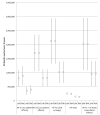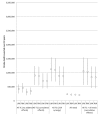The effect of tobacco control measures during a period of rising cardiovascular disease risk in India: a mathematical model of myocardial infarction and stroke
- PMID: 23874160
- PMCID: PMC3706364
- DOI: 10.1371/journal.pmed.1001480
The effect of tobacco control measures during a period of rising cardiovascular disease risk in India: a mathematical model of myocardial infarction and stroke
Abstract
Background: We simulated tobacco control and pharmacological strategies for preventing cardiovascular deaths in India, the country that is expected to experience more cardiovascular deaths than any other over the next decade.
Methods and findings: A microsimulation model was developed to quantify the differential effects of various tobacco control measures and pharmacological therapies on myocardial infarction and stroke deaths stratified by age, gender, and urban/rural status for 2013 to 2022. The model incorporated population-representative data from India on multiple risk factors that affect myocardial infarction and stroke mortality, including hypertension, hyperlipidemia, diabetes, coronary heart disease, and cerebrovascular disease. We also included data from India on cigarette smoking, bidi smoking, chewing tobacco, and secondhand smoke. According to the model's results, smoke-free legislation and tobacco taxation would likely be the most effective strategy among a menu of tobacco control strategies (including, as well, brief cessation advice by health care providers, mass media campaigns, and an advertising ban) for reducing myocardial infarction and stroke deaths over the next decade, while cessation advice would be expected to be the least effective strategy at the population level. In combination, these tobacco control interventions could avert 25% of myocardial infarctions and strokes (95% CI: 17%-34%) if the effects of the interventions are additive. These effects are substantially larger than would be achieved through aspirin, antihypertensive, and statin therapy under most scenarios, because of limited treatment access and adherence; nevertheless, the impacts of tobacco control policies and pharmacological interventions appear to be markedly synergistic, averting up to one-third of deaths from myocardial infarction and stroke among 20- to 79-y-olds over the next 10 y. Pharmacological therapies could also be considerably more potent with further health system improvements.
Conclusions: Smoke-free laws and substantially increased tobacco taxation appear to be markedly potent population measures to avert future cardiovascular deaths in India. Despite the rise in co-morbid cardiovascular disease risk factors like hyperlipidemia and hypertension in low- and middle-income countries, tobacco control is likely to remain a highly effective strategy to reduce cardiovascular deaths.
Conflict of interest statement
The authors have declared that no competing interests exist.
Figures






Similar articles
-
Palm oil taxes and cardiovascular disease mortality in India: economic-epidemiologic model.BMJ. 2013 Oct 22;347:f6048. doi: 10.1136/bmj.f6048. BMJ. 2013. PMID: 24149818 Free PMC article.
-
Impact on cardiovascular disease events of the implementation of Argentina's national tobacco control law.Tob Control. 2014 Mar;23(2):e6. doi: 10.1136/tobaccocontrol-2012-050599. Epub 2012 Oct 23. Tob Control. 2014. PMID: 23092886 Free PMC article.
-
Impact of Total Indoor Smoking Ban on Cardiovascular Disease Hospitalizations and Mortality: The Case of Chile.Nicotine Tob Res. 2024 Aug 22;26(9):1166-1174. doi: 10.1093/ntr/ntae045. Nicotine Tob Res. 2024. PMID: 38457437 Free PMC article.
-
Tobacco Use Worldwide: Legislative Efforts to Curb Consumption.Ann Glob Health. 2018 Nov 5;84(4):571-579. doi: 10.9204/aogh.2362. Ann Glob Health. 2018. PMID: 30779502 Free PMC article. Review.
-
Lowering blood pressure to prevent myocardial infarction and stroke: a new preventive strategy.Health Technol Assess. 2003;7(31):1-94. doi: 10.3310/hta7310. Health Technol Assess. 2003. PMID: 14604498 Review.
Cited by
-
Addressing disparities in the global epidemiology of stroke.Nat Rev Neurol. 2024 Apr;20(4):207-221. doi: 10.1038/s41582-023-00921-z. Epub 2024 Jan 16. Nat Rev Neurol. 2024. PMID: 38228908 Review.
-
Prevalence and associated factors of cardiovascular diseases among men and women aged 45 years and above: Analysis of the longitudinal ageing study in India, 2017-2019.Indian Heart J. 2023 Jan-Feb;75(1):31-35. doi: 10.1016/j.ihj.2022.12.003. Epub 2022 Dec 19. Indian Heart J. 2023. PMID: 36549638 Free PMC article.
-
Association of anthropometric measures of obesity and physical activity with cardio-vascular diseases among older adults: Evidence from a cross-sectional survey, 2017-18.PLoS One. 2021 Dec 15;16(12):e0260148. doi: 10.1371/journal.pone.0260148. eCollection 2021. PLoS One. 2021. PMID: 34910748 Free PMC article.
-
A decade after introducing MPOWER, trend analysis of implementation of the WHO FCTC in the Eastern Mediterranean Region.Lung India. 2020 Mar-Apr;37(2):120-125. doi: 10.4103/lungindia.lungindia_388_19. Lung India. 2020. PMID: 32108595 Free PMC article.
-
Impact of India's National Tobacco Control Programme on bidi and cigarette consumption: a difference-in-differences analysis.Tob Control. 2020 Jan;29(1):103-110. doi: 10.1136/tobaccocontrol-2018-054621. Epub 2018 Dec 15. Tob Control. 2020. PMID: 30554161 Free PMC article.
References
-
- Narayan KM, Ali MK, Koplan JP (2010) Global noncommunicable diseases—where worlds meet. N Engl J Med 363: 1196–1198. - PubMed
-
- Reddy KS, Yusuf S (1998) Emerging epidemic of cardiovascular disease in developing countries. Circulation 97: 596–601. - PubMed
-
- Leeder S, Raymond S, Greenberg H (2004) A race against time: the challenge of cardiovascular disease in developing economies. New York: Columbia University.
-
- Shah B, Kumar N, Menon G, Khurana S, Kumar H (2010) Assessment of burden of non-communicable diseases. Delhi: World Health Organization India.
Publication types
MeSH terms
Grants and funding
LinkOut - more resources
Full Text Sources
Other Literature Sources
Medical


